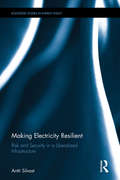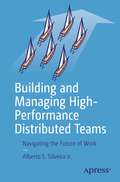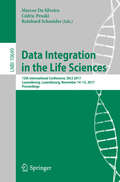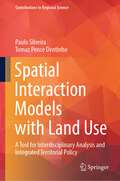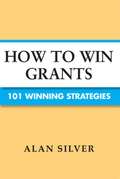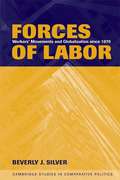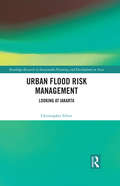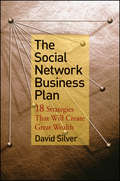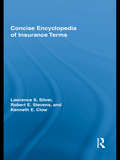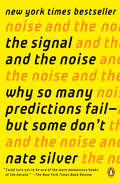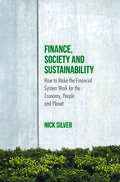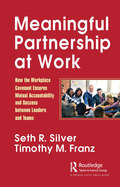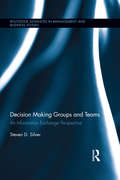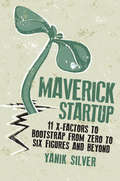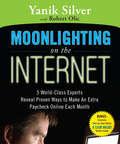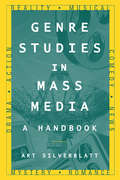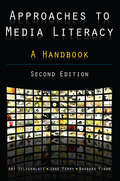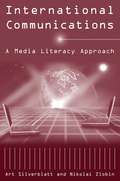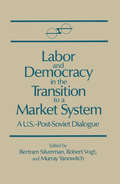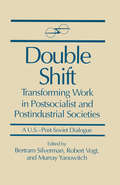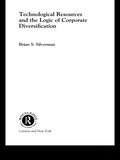- Table View
- List View
Making Electricity Resilient: Risk and Security in a Liberalized Infrastructure (Routledge Studies in Energy Policy)
by Antti SilvastEnergy risk and security have become topical matters in Western and international policy discussions; ranging from international climate change mitigation to investment in energy infrastructures to support economic growth and more sustainable energy provisions. As such, ensuring the resilience of more sustainable energy infrastructures against disruptions has become a growing concern for high-level policy makers. Drawing on interviews, participant observation, policy analysis, and survey research, this book unpacks the work of the authorities, electricity companies, and lay persons that keeps energy systems from failing and helps them to recover from disruptions if they occur. The book explores a number of important issues: the historical security policy of energy infrastructures; control rooms where electricity is traded and maintained in real time; and electricity consumers in their homes. Presenting case studies from Finland and Scandinavia, with comparisons to the United States, the United Kingdom, and the European Union at large, Making Electricity Resilient offers a detailed and innovative analysis of long-term priorities and short-term dynamics in energy risk and resilience. This book will be of great interest to students and scholars of energy policy and security, and science and technology studies.
Sociology of Interdisciplinarity: The Dynamics of Energy Research
by Antti Silvast Chris FouldsThis Open Access book builds upon Science and Technology Studies (STS) and provides a detailed examination of how large-scale energy research projects have been conceived, and with what consequences for those involved in interdisciplinary research, which has been advocated as the zenith of research practice for many years, quite often in direct response to questions that cannot be answered (or even preliminarily investigated) by disciplines working separately. It produces fresh insights into the lived experiences and actual contents of interdisciplinarity, rather than simply commentating on how it is being explicitly advocated. We present empirical studies on large-scale energy research projects from the United Kingdom, Norway, and Finland. The book presents a new framework, the Sociology of Interdisciplinarity, which unpacks interdisciplinary research in practice. This book will be of interest to all those interested in well-functioning interdisciplinary research systems and the dynamics of doing interdisciplinarity, including real ground-level experiences and institutional interdependencies.
Building and Managing High-Performance Distributed Teams: Navigating the Future of Work
by Alberto S. Silveira Jr.The age of the distributed team is upon us. Teams can now operate and collaborate from locations other than a central office, and events surrounding the 2020 COVID pandemic have thrown its practicality into sharp relief. Managing a team whose members are distributed across several locations requires a different mindset and will remain a must-have for all areas of business from this point forward.Building and Managing High-Performance Distributed Teams explains what the distributed teams concept means to the future of your company. Author Alberto S. Silveira Jr. leverages his industry knowledge to explore why the high-performance distributed team model is vital to the future of business, and explains how to build and maintain one through times of change. You will learn to differentiate between distributed teams, remote work, offshoring, and what each means in a modern context. Silveira also weaves in stories from his other life as a boater and sailor, using analogies and lessons gained from humankind’s thousands of years of maritime adventure to illustrate the value of well-managed teams, and to also convey the importance of life-work balance in today’s working world.The book analyzes team management strategies from some of the great successes and failures in recent years so that you can learn from the experiences of others. Building and Managing High-Performance Distributed Teams is your definitive guide for building a dynamic distributed team, using collaboration technology to attract and engage the most important element of any business—your people. Whether you are a department head, a business owner, or a team leader, this book presents the no-nonsense knowledge you need now to chart your course for success. What You Will LearnUnderstand what the new era of connected business means, and the role distributed teams will play.Differentiate between distributed teams, remote work, nearshore, and offshoring, and what each means to modern business.Discover the true heart of a high-performance distributed team (hint: it’s not the technology).Find out what the era of distributed teams means to existing infrastructure.Uncover what we can learn about team management from some of the great successes and failures of recent years.Appreciate the techniques honed by seafarers, pilots, and software designers combined to create a successful project plan for team management and company navigation.Comprehend the effective simplicity of the “power of three” in building successful teams.Apply proven techniques of measurement and metrics without leaving the human factor behind to improve team morale and productivity. Who This Book Is ForTeam leaders or officers of small-ish companies, with populations in the tens through to the mid-hundreds. It’s also for managers of somewhat autonomous departments within larger companies, and for everyone else in the boat because everyone in a company ultimately needs to know what being in a distributed team is all about.
Data Integration in the Life Sciences: 12th International Conference, DILS 2017, Luxembourg, Luxembourg, November 14-15, 2017, Proceedings (Lecture Notes in Computer Science #10649)
by Marcos Da Silveira Cédric Pruski Reinhard SchneiderThis book constitutes the proceedings of the 12th International Conference on Data Integration in the Life Sciences, DILS 2017, held in Luxembourg, in November 2017. The 5 full papers and 5 short papers presented in this volume were carefully reviewed and selected from 16 submissions. They cover topics such as: life science data modelling; analysing, indexing, and querying life sciences datasets; annotating, matching, and sharing life sciences datasets; privacy and provenance of life sciences datasets.
Spatial Interaction Models with Land Use: A Tool for Interdisciplinary Analysis and Integrated Territorial Policy (Contributions to Regional Science)
by Paulo Silveira Tomaz Ponce DentinhoThis book develops spatial interaction models for the analysis of human interaction within space, in terms of both accessibility and land use. Presenting case studies on the Azores and Morocco, it covers applications in various regions of Europe and Africa. The respective models simulate land use, employment, households, commuting and shopping movements and land values, employment distribution for basic activities, changes in accessibility, and changes in land suitability due to climate change.This book will appeal to scholars and students of regional and spatial science, ecological economics, and agricultural economics, as well as to spatial planners and practitioners dealing with issues of spatial planning to address such problems as unsustainable land use, adaptation to climate change, desertification of rural areas heavily dependent on land use, and the impacts of external shocks on land and property values.
How to Win Grants: 101 Winning Strategies
by Alan SilverConcisely written and easy to follow, How to Win Grants demonstrates a three-stage grant development model distilled into 101 actionable strategies, arranged in order of execution and supplemented by helpful checklists. In stage one, "Prepare," grantseekers begin by assessing their personal and agency fundability, improving their positioning for grants, learning shortcuts to planning successful grant projects, and finding out how to locate the most likely sources of grant funding. In stage two, "Persuade," grantseekers learn how to convince private and public grantmakers that their project deserves funding by adapting their project plan to the specific needs of each funder. In stage three, "Perform," readers learn the most important ways to continue attracting grant funding for the long term. This indispensable guide also dispels widespread myths about grantseeking, identifies unproductive behaviors to avoid, and teaches readers how to engage the funder's interest and make the most compelling case for their project. With all this and more, How to Win Grants is every individual and organization's ticket to a winning grantseeking campaign!
Forces of Labor: Workers' Movements and Globalization Since 1870 (Cambridge Studies in Comparative Politics)
by Beverly J. SilverRecasting labor studies in a long-term and global framework, the book draws on a major new database on world labor unrest to show how local labor movements have been related to world-scale political, economic, and social processes since the late nineteenth century. Through an in-depth empirical analysis of select global industries, the book demonstrates how the main locations of labor unrest have shifted from country to country together with shifts in the geographical location of production. It shows how the main sites of labor unrest have shifted over time together with the rise or decline of new leading sectors of capitalist development and demonstrates that labor movements have been deeply embedded (as both cause and effect) in world political dynamics. ,p>Over the history of the modern labor movement, the book isolates what is truly novel about the contemporary global crisis of labor movements. Arguing against the view that this is a terminal crisis, the book concludes by exploring the likely forms that emergent labor movements will take in the twenty-first century.
Urban Flood Risk Management: Looking at Jakarta (Routledge Research in Sustainable Planning and Development in Asia)
by Christopher SilverLike so many of the coastal cities in Southeast Asia (and other regions) established during European colonialism, there has been an ongoing challenge for decades dealing with the growing frequency and intensity of flooding. Jakarta’s flood problems since the 1990s have been nothing less than monumental and the inability of the local and national governments to mitigate flooding in Jakarta is the most visible manifestation of fundamental water management deficiencies. This book offers a comprehensive and systematic historical assessment of Jakarta’s water management practices from the colonial era through the early years of the Indonesian republic and Jakarta’s emergence as a sprawling megacity. This book draws upon a vast multidisciplinary literature and a wide array of government documents to unravel the complex history of water management that has led to approximately 40% of the city now lying below sea level. This book will be a useful reference to those who research on topics such as urbanization in Southeast Asia, sustainable development, urban and planning history, environmental planning, issues of water management (and flooding) and the politics of planning and development.
The Social Network Business Plan
by David SilverAll of us know that users of the Web do not read advertisements on the websites we visit, yet the online communities are emerging as the next great media rely solely on this method to produce revenue. In The Social Network Business Plan, social network expert, David Silver presents and explains 18 cutting-edge methods to create revenue for social network websites--none of which are advertising. He also predicts the demise of seemingly successful online communities such as MySpace and Facebook that rely on advertising as non-sustainable modalities. Silver describes and explains that in the future new products and services will be introduced, talked about, rated, reviewed and recommended - or killed - by online communities. One example of the 18 new revenue channels that online communities are adopting is the sale to vendors of anonymized conversations of the community members concerning those vendors' products or services. Another example is online communities who partner with the internet providers to receive payment when a particular online community's information is downloaded usinf that providers service. The other sixteen revenue channels are equally head-turning!Silver is the only angel investor, operating down where the rubber meets the road, who is investing in online communities in their infancy, and writing about which ones will win and which ones will fail.
Concise Encyclopedia of Insurance Terms
by Lawrence Silver Robert E Stevens Kenneth ClowThe purpose of the book is to provide insurance practitioners, consumers, and students with definitions of common insurance terms in both the property/casualty and life/health insurance industries. The unique feature of the book is that many of the definitions contain detailed explanations of coverage provided by certain types of insurance and/or examples that illustrate how a particular coverage works. The book should be helpful to insurance agents and to new insurance agency/company personnel. It will also be helpful to consumers to use as a reference guide to better understand insurance products the consumer needs. Finally, it will be useful as a reference guide for students in business courses.
The Hedonic Country Product Dummy Method and Quality Adjustments for Purchasing Power Parity Calculations
by Mick SilverA report from the International Monetary Fund.
An Index Number Formula Problem: The Aggregation of Broadly Comparable Items
by Mick SilverA report from the International Monetary Fund.
The Signal and the Noise: Why So Many Predictions Fail-but Some Don't
by Nate SilverNate Silver built an innovative system for predicting baseball performance, predicted the 2008 election within a hair’s breadth, and became a national sensation as a blogger—all by the time he was thirty. He solidified his standing as the nation's foremost political forecaster with his near perfect prediction of the 2012 election. Silver is the founder and editor in chief of FiveThirtyEight.com.<P><P> Drawing on his own groundbreaking work, Silver examines the world of prediction, investigating how we can distinguish a true signal from a universe of noisy data. Most predictions fail, often at great cost to society, because most of us have a poor understanding of probability and uncertainty. Both experts and laypeople mistake more confident predictions for more accurate ones. But overconfidence is often the reason for failure. If our appreciation of uncertainty improves, our predictions can get better too. This is the “prediction paradox”: The more humility we have about our ability to make predictions, the more successful we can be in planning for the future.<P> In keeping with his own aim to seek truth from data, Silver visits the most successful forecasters in a range of areas, from hurricanes to baseball, from the poker table to the stock market, from Capitol Hill to the NBA. He explains and evaluates how these forecasters think and what bonds they share. What lies behind their success? Are they good—or just lucky? What patterns have they unraveled? And are their forecasts really right? He explores unanticipated commonalities and exposes unexpected juxtapositions. And sometimes, it is not so much how good a prediction is in an absolute sense that matters but how good it is relative to the competition. In other cases, prediction is still a very rudimentary—and dangerous—science.<P> Silver observes that the most accurate forecasters tend to have a superior command of probability, and they tend to be both humble and hardworking. They distinguish the predictable from the unpredictable, and they notice a thousand little details that lead them closer to the truth. Because of their appreciation of probability, they can distinguish the signal from the noise.<P> <P><b>A New York Times Bestseller</b> With everything from the health of the global economy to our ability to fight terrorism dependent on the quality of our predictions, Nate Silver’s insights are an essential read.
Finance, Society and Sustainability: How to Make the Financial System Work for the Economy, People and Planet
by Nick SilverThis book is a critical analysis of the impact of the financial system on the economy, society and the natural environment. It cuts through the noise to looks at its purpose, its activities, and what it does in practice.Unlike other books that cover the last financial crisis and the risk of another one; this book is about the consequence of the financial system continuing in its current form. It argues that the financial system is a construct of flawed economic theories, designed in the hope that the market will efficiently allocate society’s capital. Instead, the finance sector allocates savings and investment to maximize its own revenues, with resulting collateral damage to the economy, society and the environment.Although governments try to preserve and regulate the existing system, it is being replaced by a new system driven by technological innovation. The book describes the opportunities this presents for a renaissance of the financial system to actually meet the needs of society, and to re-engineer our economy to avoid environmental crisis.The book is for anyone who would like to understand the finance system’s purpose, what it does in practice and its impact on the real world. For those working in the industry it provides an overview of the system, their place within it, and how to bring about change. For students and academics it provides a valuable critique of the financial system, and the theories on which it is based. For financial policymakers and regulators it identifies key challenges in their activities.
Meaningful Partnership at Work: How The Workplace Covenant Ensures Mutual Accountability and Success between Leaders and Teams
by Seth Silver Timothy FranzWhy are some work partnerships exceptional while most are not? How can we establish and sustain an enhanced level of cohesion, connection, and collaboration in the most important work relationship, the one between a manager and team? What could remedy the high levels of isolation and anxiety so many feel at work these days? Silver and Franz explore the concept of ‘meaningful partnership’ in the workplace. They present meaningful partnership as a mindset where both leaders and their teams are fully committed to ensuring the support and success of the other. Then, they describe a model called ERTAP, which stands for Empathy, Respect, Trust, Alignment, and Partnership, which is the foundation for meaningful partnership. Finally, they detail a practical yet transformative relationship-building process referred to as the Workplace Covenant. This enables leaders and teams to create mutual commitments with obligatory weight that help them to feel accountable for the success of the relationship and each other.The book includes real client stories that illustrate the dimensions of partnership and the Workplace Covenant process. Silver and Franz also outline other work relationships that can benefit from meaningful partnership, pitfalls to avoid, relevant research, and insights derived from years of consulting experience. This book is a must-read for leaders interested in a better working relationship with their team; for teams who have critical work partnerships with other teams; for individuals who work closely with other individuals and need an exceptional 1:1 partnership; and finally for third-party experts in HR or continuous improvement who are seeking a new powerful way to help clients feel supported and be more successful.
Meaningful Partnership at Work: How The Workplace Covenant Ensures Mutual Accountability and Success between Leaders and Teams
by Seth R. Silver Timothy M. FranzWhy are some work partnerships exceptional while most are not? How can we establish and sustain an enhanced level of cohesion, connection, and collaboration in the most important work relationship, the one between a manager and team? What could remedy the high levels of isolation and anxiety so many feel at work these days? Silver and Franz explore the concept of ‘meaningful partnership’ in the workplace. They present meaningful partnership as a mindset where both leaders and their teams are fully committed to ensuring the support and success of the other. Then, they describe a model called ERTAP, which stands for Empathy, Respect, Trust, Alignment, and Partnership, which is the foundation for meaningful partnership. Finally, they detail a practical yet transformative relationship-building process referred to as the Workplace Covenant. This enables leaders and teams to create mutual commitments with obligatory weight that help them to feel accountable for the success of the relationship and each other. The book includes real client stories that illustrate the dimensions of partnership and the Workplace Covenant process. Silver and Franz also outline other work relationships that can benefit from meaningful partnership, pitfalls to avoid, relevant research, and insights derived from years of consulting experience. This book is a must-read for leaders interested in a better working relationship with their team; for teams who have critical work partnerships with other teams; for individuals who work closely with other individuals and need an exceptional 1:1 partnership; and finally for third-party experts in HR or continuous improvement who are seeking a new powerful way to help clients feel supported and be more successful.
Decision-Making Groups and Teams: An Information Exchange Perspective (Routledge Advances in Management and Business Studies)
by Steven SilverIn recent years, there has been increasing implementation of group and team decision-making within organizations, much of it managed electronically, between members of what are "virtual" groups or teams. Recent research into effective team implementation emphasizes "trust" as an intermediary process, and trust must be a part of any account of team decision-making. This book provides an integrated framework that represents process in decision-making by interactive groups and teams. This framework furthers both our understanding of process and our capabilities in implementation, based on an account of group decision-making that differentiates the information types contributing to decision quality and relates them to process in interactive groups and teams. Author Steve Silver emphasizes the social structure that is inherent in the interaction of decision-makers as group or team members and effects on the information they exchange.
Maverick Startup
by Yanik SilverThe Intangibles. The X-Factors.1. The Big Idea2. Your Vision3. High Margins and Premium Prices4. Get It Out The Door5. Test and Improve6. Listen and Shift7. Create Zealots8. What's Next?9. Tap Your Mastermind10. Create the Fun11. Create the ImpactShattering the myth that you need money to make money, serial entrepreneur and millionaire Yanik Silver reveals the 11 X-Factors to turn your big idea into even bigger profits-without taking on debt, partnering with outside investors, or even writing a business plan.We're not talking your typical B-school advice. These are the real-world, underground insights that can take your idea from a little concept on a napkin to throwing off serious revenue in a way that supports and builds up whatever else is important to youThese maverick rules are the "little hinges" that swing big doors of opportunity, applied by the most successful and innovative entrepreneurs who dared to fast track their big idea, blaze their own path and simply write their own rules for success.The MAVERICK philosophy:Set your own rulesMake more moneyHave more funExperience a rich lifeAnd give more to make a difference
Moonlighting on the Internet
by Yanik SilverInternet marketing guru Yanik Silver has scoured the internet to bring together 5 world-class experts who make thousands in extra cash online each month. They reveal their secrets to making unlimited cash using today's hottest online moneymaking methods: selling information, eBay, affiliate marketing, Yahoo! Stores and blogging.
Genre Studies in Mass Media: A Handbook
by Art SilverblattThe study of various types of programming is essential for critical analysis of the media and also offers revealing perspectives on society's cultural values, preoccupations, behavior, and myths. This handbook provides a systematic, in-depth approach to the study of media genres - including reality programs, game shows, situation comedies, soap operas, film noir, news programs, and more. The author addresses such questions as: Have there been shifts in the formula of particular genres over time? What do these shifts reveal about changes in culture? How and why do new genres - such as reality TV shows - appear? Are there differences in genres from one country to another? Combining theoretical approaches with concrete examples, the book reinforces one's understanding of the importance of genre to the creation, evolution, and consumption of media content. Each chapter in this reader-friendly book contains a detailed discussion of one of the theoretical approaches to genre studies, followed by Lines of Inquiry, which summarizes the major points of the discussion and suggests directions for analysis and further study. Each chapter also includes an example that illustrates how the particular theoretical approach can be applied in the analysis of genre. The author's careful linkage of different genres to the real world makes the book widely useful for those interested in genre study as well as media and culture, television studies, film studies, and media literacy.
Approaches to Media Literacy: A Handbook
by Art Silverblatt Jane Ferry Barbara FinanCompletely updated, with current examples and new coverage of digital media, this popular handbook provides a range of qualitative approaches that enable students to effectively decipher information conveyed through the channels of mass communication - photography, film, radio, television, and interactive media. It aim is to help students develop critical thinking skills and strategies with regard to what media to use and how to interpret the information that they receive. The techniques include ideological, autobiographical, nonverbal, and mythic approaches. An Instructor's Manual is available to professors who adopt this new edition.
International Communications: A Media Literacy Approach
by Art Silverblatt Nikolai ZlobinInternational communication affects the way we think about other countries and their people and sets the agenda of issues that face the global community. This book introduces the functions of international communications.
Labor and Democracy in the Transition to a Market System
by Bertram Silverman Robert Vogt Murray YanovichNowhere is the tension attending simultaneous political democratization and economic liberalization more sharply felt than in the realm of labour relations. What is happening in Soviet trade unions today? How will the emerging independent unions respond to anticipated rises in unemployment? What kind of social regulation of the labour market will be appropriate in the future? These papers from a pathbreaking US-Soviet conference on labour issues reveal a considerable diversity of views on questions whose resolution will be essential to social peace in this period of transition. Among the noted contributors are Joseph Berliner, Sam Bowles, Richard Freeman, Leonid Gordon, V.L.Kosmarskii, Alla Nazimova, Michael Piore, Boris Rakitskii, Iurii Volkov, Ben Ward and Tatiana Zaslavskaia.
Double Shift: Transforming Work in Postsocialist and Postindustrial Societies (U. S. - Post-soviet Dialogues Ser.)
by Bertram Silverman Robert Vogt Murray YanowitchTaken from a series of conferences, this collection of papers by leading labour experts from the United States and the former Soviet Union examines the profound changes in industrial systems and work organisation currently affecting both societies. The authors focus on the emergence of new labour market institutions, the evolution of managerial philosophy, changes in workers' values and attitudes toward economic security, economic inequality, and the legitimacy of worker participation in management and ownership. Comparison reveals both striking differences and similarities in the transformation of the two systems in the post-industrial age, and helps demystify some simplistic notions about the workings of market systems.
Technological Resources and the Logic of Corporate Diversification (Routledge Studies In Global Competition Ser. #Vol. 13)
by Brian S SilvermanThis impressive book sees the author applying and extending the resource based view of the firm to explain and predict the strategy of corporate diversification.Technological Resources and the Logic of Corporate Diversification is an original and authoritative book that will be extremely useful to academics and students in such disciplines as busin
